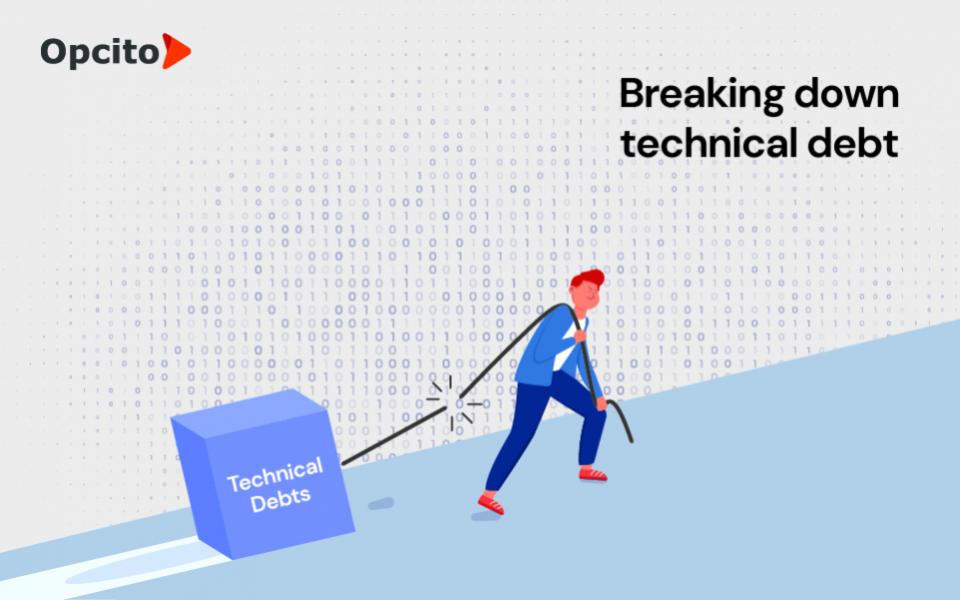Software organizations are under constant pressure to deliver software at the earliest due to market demands and cut-throat competition. This might sometimes lead to potentially releasing software that is with immature code. These software function properly and pass through the normal QA checks but having immature code in excess quantities may lead to various issues. Typical scenarios like these where organizations release software without complete code and where they must come back at some point to fix the code is termed a technical debt. Reducing technical debts is boosts delivery times and is a good approach to cost savings. A recent Gartner study shows that through 2023, I&O leaders responsible for actively managing and reducing tech debt will achieve at least 50% faster service delivery times for the business. This piece will explain what technical debt is along with its types, causes, and effects on businesses, and tell you how to competently manage debts.
What is technical debt?
Technical debt (code debt, tech debt, or simply TD) occurs when teams release a project or a piece of functionality that needs to be refactored later in order to accelerate the delivery. Tech debt is the result of prioritization of speedy delivery over perfect code. It means taking shortcuts in software development to hit short-term goals momentarily but paying back with re-work in the future.
It typically occurs when developers rely on sub-optimal, easy-to-implement design solutions or coding to speed up production or use a ready-made code instead of customized solutions. They must fix the code at some point in the future because the solution they implement is temporary. Leaving it unaddressed hinders innovation and competitiveness and limits organizations' ability to adapt and grow. Managing technical debt properly plays a vital role in the long-term success or failure of software projects.
Listed below are common reasons why companies tolerate tech debt:
- Budget and time limitations
- Strategic decision to test the market
- Poor choice of software design
- Lack of development and coding skills
- Flawed business decisions
Having technical debts for a short period can be overlooked, but they need prompt addressing. Keeping them for an extended period can unnecessarily become time-consuming, expensive, and constraining to fix in the future. Unaddressed technical debts have symptoms like:
- Longer release cycles
- Longer time to market
- Performance issues from bugs
- Code quality concerns
- Negative UX
- Lower team agility and productivity
- Cybersecurity flaws
- Challenges in adopting new technologies
Types of tech debt
Based on intent, tech debts can be of four types - reckless, prudent, deliberate, or inadvertent. When you combine all these, we get the following tech debts.

Let’s look at each debt closely. Try to avoid the left side of the quadrant as far as possible.
-
Deliberate and reckless: This happens when teams know they are entering into technical debt but still move forward without analyzing all the consequences. Even though the decision is intentional, this approach may lead to poor outcomes in the future and is not precisely the ideal strategy.
-
Deliberate and prudent: Like the earlier type, teams know they are entering a tech debt, but they analyze all the consequences before taking the step. The team considers the tech debt acceptable if the payoff for an earlier release is higher than what the technical debt costs.
-
Inadvertent and reckless: This is undoubtedly the most dangerous type of debt. Here, teams blindly implement solutions mainly due to a lack of experience. The best way to avoid this situation is to hire and employ developers with experience and sound knowledge of handling code debt.
-
Inadvertent and prudent: This is a controlled scenario where a knowledgeable tech team applies the best practices to develop the software and is fully aware when they are entering into a tech debt due to unseen coding mistakes. Numerous predictions and analysis can be made, but implementing the code can bring out bugs and improvement areas.
What causes technical debt?
Experience and earlier data can help predict many things during software development, but something will always slip between the cracks while perfecting code. Not everything can be under control, leading to technical debt setting in. Let's look at three key reasons for technical debt:
-
Short timelines: Often, the pressure to deliver within timelines makes dev teams release apps that are not full-featured and without key capabilities. They may even skip steps and compromise on performance to reach the market quickly.
-
Constant change: Even applications that are completed on time following all the development protocols get outdated in today's fast-paced software development ecosystem. To top it, customer demands keep evolving, new market opportunities arise, and unknown cyber threats take root, making it very challenging for IT leaders to keep up with the changes.
-
Outdated technology: Modern applications involve several coding languages, libraries, and developer frameworks. These become obsolete quickly and may need to be updated regularly.
Technical debt always begins from the first day of development, even though not totally visible. You can't completely take it out, but you can manage it and minimize it as much as possible.
Effects of technical debt
Not all debts are bad and unintended! Yes, it is true, mainly when the tech debt aids your organization in achieving a bigger goal – it can be overlooked. Lean software development methods and the urge to push products to the market at the earliest have led companies to believe it is okay having a technical debt. But, leaving the debt unattended for too long can have serious consequences, leading to severe issues.
Here's a look at impacts of tech debt on businesses:
-
Slowed forward motion: When a technical debt gets out of control, dev teams spend a lot of time paying off "interest payments" instead of working on new updates or critical features. Instead of catering to new change requests, teams may spend hours, days, or weeks tackling the 'quick and dirty' code and ensuring that the debt is cleared, hampering the product's advancement.
-
Poorly designed code: If developers take the quick and dirty approach to reach a deadline, they could skip many protocols of writing organized and clean codes, messing with the code structure and affecting its readability. Undesirable practices such as loosely stringing code modules and using different code styles on different occasions can complete the project in time. Still, poor designed code will make it challenging for a different developer to work on the project in the future.
-
Drained productivity: Accumulated technical debt slowly drains productivity and delays output. It puts much pressure on dev teams and may consume a lot of their time. For example, a job that usually takes three weeks to complete may take more time. All this is at the risk of postponing other projects. A technical debt not only slows down build times but also slows down the overall production, testing, and release cycles. New feature requests may run into the challenge of new bugs due to poorly written code, making it challenging for teams to test.
-
Testing strain: With fast-approaching deadlines, testing teams may be forced to accelerate their testing process, hurriedly run them, skip steps, or even possibly miss tests. This leads to incurring technical debt, eventually making the dev team go back and complete the steps that were missed. It can cause a negative impact due to rushed and minimal testing. Accumulated tech debts can cause a snowball effect and easily strain the dev and testing teams, leaving no room for future developments and affecting the team's overall productivity.
-
Staffing issues: Developers are not always open to working on old technologies because their aim is to mainly work with new, cutting-edge technologies. It becomes challenging to replace a developer who has worked on the code earlier and understands the intricacies. Since codes in a tech debt can be very unclear, a developer's willingness to work on such codes reduces drastically, making organizations run from pillar to post to find a developer willing to tackle the technical debt.
The role of DevOps in resolving technical debt
Although DevOps does not resolve all technical debt problems, it sure is handy in reducing and controlling them. Automation is used extensively in DevOps and CI/CD, and many time-consuming tasks can be automated. This has two benefits. Firstly, automation saves time by performing tasks very fast. It also reduces the chance of errors, thus reducing the instances of re-work. Automation such as automated builds and automated testing, incorporated into the CI/CD process, also helps identify tech debt much earlier. In the case of code quality, automation ensures that quality standards are maintained, and technical debts are reduced.
Communication, another DevOps aspect, helps a lot while managing technical debt. DevOps practices like keeping an operational calendar provide an excellent platform for tracking and cataloging. They play an essential role in transparent communication between different stakeholder teams. Another technical debt management strategy that DevOps organizations use is implementing shared, self-service pipelines to conduct common tasks like building containers, compiling code, deploying to an environment, or performing tests. Sharing these activities across teams help organizations enforce a common technical language to discuss organizational issues and activities.
How to avoid technical debt?
Technical debt grows daily, and the ideal time to implement a process to solve it is doing it now. Let's look at some of the proven methods to fight and prevent tech debt:
-
Refactoring: The most straightforward way to prevent and resolve design and code debt is to conduct regular refactoring at regular intervals. Organizing something like a dedicated refactoring week allows the dev team to evaluate the current architecture, resolve open bugs, and prepare the architecture for upcoming product features. It also helps developers assess the code and reflect on it before implementing the new features. It is an excellent method for solving big pieces of debt.
-
Conduct technical debt discussions regularly: Knowledge sharing is essential among engineers. Not only engineers but also involving other stakeholders like product owners in the discussion will create a shared understanding of the issues engineers encounter. It also gives stakeholders a better insight into the codebase so that they understand what exactly went well and what didn't. The discussion should avoid blame games at all costs and must only be used to deliver professional feedback while looking at improvement areas.
-
Use tools to track technical debt: Making it easier for engineers to solve technical problems is one of the best things to do for the codebase's health. Maintaining track of the tech debts helps engineers get total visibility of technical debts, reduce context switching, see the context for each codebase issue and solve tech debt continuously. Implementing processes to manage technical debt accurately will positively affect the engineering team's morale, help them handle debts better, and indirectly improve the product's overall customer satisfaction.
Is tech debt bad?
Simply put, it is purely situational. It is a situation which certainly needs to be avoided. However, almost every software organization faces pressure from the market and competitors to deliver software soon. Most software products, if not all, have tech debt to an extent. Start-ups especially face this challenge of speedy delivery, and this demand leads them to choose between embracing technical debt or delay. Weigh your options well before embracing technical debt, keep it to minimal levels where possible, because it is always good practice to avoid debts.




































